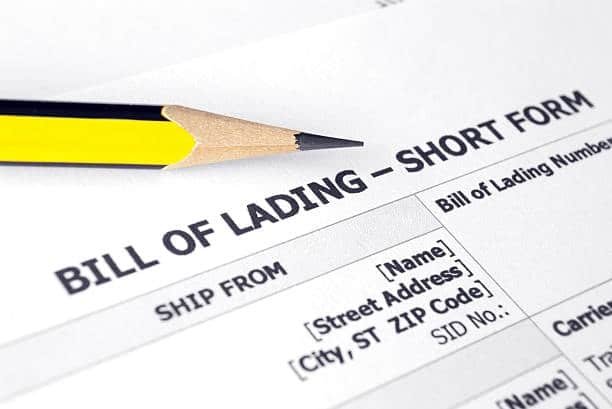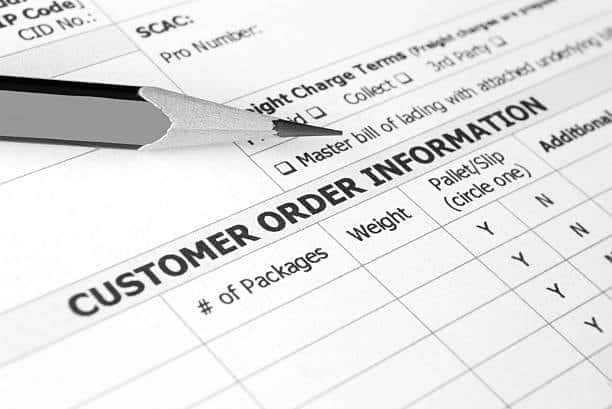It is very important for exporters, importers and freight forwarders to know when a bill of lading will be issued in international shipping and logistics, as the lading important aspects can greatly affect the proces . The guide covers how to time the issuance of bills of lading, their legal considerations and what best practices to follow in global trade.

GWT Worldwide: This is Shenzhen Guanwutong International Freight Forwarding Co., Ltd. (GWT Worldwide), a freight forwarder and provider of logistics services mainly focusing on international freight forwarding, supply chain management and cross-border e-commerce logistics. Thanks to their knowledge in air freight, sea freight, China-Europe railways, international express methods, customs procedures and Amazon FBA support, GWT Worldwide guarantees your goods are transported safely and lawfully all the way to the destination with modern logistics technology and a significant number of trusted partners worldwide.
What is a Bill of Lading and Why Does Timing Matter?

In international trade, the B/L proves to be a crucial legal document since it serves as a receipt, a contract and a title for delivering goods. When the bill of lading is released can affect who the goods belong to, the payments involved and the legal rules for everyone during shipping.
It matters greatly when one understands when a bill of lading will be issued, especially for the parties involved in the transaction . It has an influence on how payments are arranged, whether goods are insured and legal accountability. If a business is involved in trade across countries, when they start to work with the INCOTERMS can decide whether the transaction will be without problems or full of arguments.
New shipping methods have adjusted to match businesses’ needs which is why several bills of lading are often issued at various points in the shipping chain. There are differences in each document issued and they are released at specific times in line with both operation needs and legal procedures.
Standard Timeline for Bill of Lading Issuance

Bill of lading issuance has traditionally been done according to a well-known industry procedure. Cargo is usually taken to the port or terminal, checked and then given the right paperwork to acknowledge receipt . Usually, the documents are issued within 24 to 48 hours after the vessel leaves the port where it was loaded.
This sequence of events is used for practical purposes. Shipping companies need to carefully examine cargo, plan how the goods will be stored on the ship and check all related documents before they agree to the bill of lading commitments. The document shows that the cargo was received and promises to transport the goods to the destination address.
Nevertheless, new demands in logistics have caused changes in this timeframe. Due to express release procedures, electronic bills of lading and streamlined documentation, it takes much less time than before in many situations. Awareness of these variations allows stakeholders to arrange their work properly and avoid signing procedures being slowed down, ensuring that only the consignee has access to the necessary documents .
Depending on the particular shipping line’s system as well as the speed at ports and type of cargo, the timing of shipments can be different. Higher-value or unique cargo may take more time to check, as standard container shipments usually keep to set schedules.
Pre-Shipment Bill of Lading: When and Why

Before a cargo is loaded or the vessel leaves, there are special bills of lading called pre-shipment bills of lading. Freight operators provide these freight bills at the request of shippers who might require extra support in getting financing such as under a letter of credit while waiting for their goods to be loaded on ships.
Getting a pre-shipment bill of lading needs close cooperation among shippers, freight forwarders and shipping lines. Carriers should be sure that their cargo, including any house bill documentation, is loaded according to the arrangements and the vessel leaves port within the given timeframe. Carriers may experience greater risk with this bill, because they are ready to transport items they haven’t physically seen yet.
Banks and trade institutions tend to request certain conditions when handling pre-shipment bills of lading. The documents should clearly say that they are pre-shipment and add statements about the actual loading of the ship, including details about the master bill . Because these documents are regulated differently by law in different places, careful attention is needed to make them enforceable.
Time-sensitive deals with letters of credit use pre-shipment bills of lading for international shipment because waiting for regular post-shipment bills would not fit the strict deadlines.
On-Board Bill of Lading Timing Requirements

On-board bills of lading confirm that the goods being shipped have been put on the ship chosen by the contract. It is easier to determine the timing of post-shipment documents, since they cannot be released until actual cargo is loaded on the vessel.
Usually, on-board bills of lading are issued within one day of finishing loading the cargo and the vessel getting underway. Because of this arrangement, shipping lines have a chance to check the stowage of the containers, compile the cargo manifests and ensure compliance with all rules and regulations. It acts as solid proof that the items are being carried by the vessel and are heading toward the destination.
Cargo work and port operations have a major effect on the time it takes to issue the on-board bill of lading. If a busy port has problems with congestion at its terminals, issuing required documents, such as a straight bill, may be delayed, but if everything goes smoothly, the process can usually be handled rapidly for urgent shipments.
The role of on-board timing in the field of law deserves much attention. It is common for international sales contracts to set delivery terms based on on-board bill of lading issuance, which is a legally binding document so it is very important for the parties to act precisely within the contract to avoid problems.
Electronic Bill of Lading and Digital Issuance
Digitalization of shipping paperwork has improved how, when and where bills of lading are issued. With electronic bills of lading, you can receive the document right after cargo is loaded or the ship departs and without paper systems.
Modern digital solutions let documents be made and exchanged immediately, so stakeholders get access to their bills of lading much faster than before. Because of this speed, companies selling abroad gain improved access to money and lower fees for transactions that take longer.
Still, using electronic bill of lading brings up some problems with laws and procedures. Different jurisdictions do not consider eBLs as legally equal to paper documents which is why banks are still uncertain about accepting them for trade finance. People within the industry are working on creating consistency and more acceptance of digital documents, including the cargo receipt .
It is especially obvious that electronic systems help most in fast moving shipments, since timely document access impacts the supply chain’s further steps.
Legal Framework Governing Issuance Timing

The timing of bill of lading issue is set by the basic rules of international maritime law. Because the Hague-Visby Rules, Hamburg Rules and Rotterdam Rules have different guidelines, the rules for bill of lading issuance are not the same everywhere.
Most legal rules require carriers to issue bill of ladings on time and accurately. These are ensuring promptness in handling and sending documents, including the order bill correct reporting of the condition and loading dates of the cargo and sticking to any timing requirements listed in the shipping contract.
Usually, legal problems occur when the bills of lading are not issued at the same time as the loading of the cargo. When examining an instrument, courts look at how it was issued, considering the business rules involved, the contract’s language and what the parties expected from each other.
Laws keep changing to keep up with current shipping practices like using electronic documents and efficient processing systems. Following legal news is necessary for all participants in worldwide shipping.
Impact of Port Operations on Issuance Schedule
How smoothly bill of lading is issued depends greatly on the efficiency of port operations, because various regions and terminals have their own processing capabilities. Some container ports with latest technology can process papers quickly, even the same day, yet with others, it may take a few days due to the lack of progress.
How swift an ATM dispenses cash depends largely on the terminal operating system. Equipped with automated container tracking, electronic records of cargo and combined shipping line computer systems, it is possible to process documents fast and avoid the likelihood of unintentional delays for bill of lading issuance.
If a port is crowded, shipping can be affected a lot, especially when there are more ships on the schedule than usual. Both parties in shipping should account for possible delays when making arrangements and planning their operations.
The connection between shipping lines and terminal operators has an effect on the speed of processing. Usually, those who work with a partner for a long time and have set processes find documents processed more accurately and quickly, while people who do so sometimes encounter delays.
Carrier Responsibilities and Timing Obligations

Serious requirements for issuing a bill of lading belong to shipping carriers in terms of both the law and operations. Some of the tasks involve precise shipping documents, including the lading document speedy handling of orders and meeting all required and contractual document deliveries.
Carriers have to ensure documents are provided quickly but are still accurate and contain everything needed. Hurrying the process can cause flights or other tasks to be done incorrectly which can result in trouble later on; on the other hand, waiting too long can interfere with customers’ operations and breach the original agreements..
Generally, the shipping industry has standards that expect standard parcels to be printed right away and more complicated shipments, particularly high-value items, may take up to 3 days to print after more checks are done.
Delayed issuance by the carrier may depend on its contract terms, current industry customs and the details of what caused the delays. Abiding by these duties gives both the carrier and the customer a clear idea of what to expect in the contract.
Shipper Requirements for Timely Issuance
To guarantee that bill of lading is issued on time, shippers should give accurate and complete shipping instructions before cargo loading. Most of the delays in processing and issuing documents are caused by inaccurate or incomplete documents.
A shipper should clearly state the nature of the cargo, the information on the consignees, proper marks and numbers for the shipment and any specific handling or paperwork. Handing these details over early means carriers can arrange and issue bills of lading right after the loading of goods.
Carriers will have unique guidelines and methods for handling paperwork, so shippers ought to be aware of them. Since each shipping line has different rules for documents, submission methods and deadlines for instructions, it is necessary to set proper procedures for each trade partner.
Shippers and carriers need to inform each other right away about any changes in shipping instructions or cargo to avoid delays and ensure the smooth issuance of bill of lading.
Regional Variations in Issuance Practices

Different places have different ways of issuing bill of lading, following their local needs, standards and customs. It is very important for global companies to know about these regional differences.
Asian ports are known for their fast and efficient approach to documents and a lot of them can give out a bill of lading the same or next day for regular shipments. It indicates that the region’s focus on getting goods out and export-trading needs fast document handling.
European nations usually focus on being accurate and following strict regulations which may take more time, but there are fewer chances for mistakes or customs delays. Trading standards in Europe give more importance to environmental and safety paperwork which results in more paperwork.
Within North America, every port and carrier uses different practices and those following regular routes are usually more predictable in their timeframes than irregular or seasonal choices. Since the post-9/11 rules were established, added security steps have pushed up the difficulty of document processing in many areas.
Technology’s Role in Accelerating Issuance

New technology has greatly decreased how long it takes to process and issue bill of lading documents in the shipping sector. After goods are loaded, automated systems now take only minutes to make the relevant documents, whereas it used to require days or weeks for this with manual work.
Many cargo businesses now use artificial intelligence and machine learning to confirm details in the cargo, look for mistakes and increase efficiency in processing documents. With these tools, issues that may cause delays during processing can be detected, so you can resolve them before forming the documents.
Blockchain may provide the answer to developing secure, instant and legal electronic bills of lading that cannot be changed by anyone. Multiple efforts are being made to try blockchain for documentation and these have led to good results in terms of processing times.
When port systems, carrier platforms and customer databases are integrated, real-time updates allow many time-consuming processes in document handling to be avoided.
Common Issues Causing Issuance Delays
Even with new advancements in technology, people still experience delays while getting their bill of lading. Errors with paperwork happen most often such as providing the wrong name of the receiver, wrong descriptions of the cargo or forgetting to include needed details for regulations.
Problems in communication between the different parties handling shipping can significantly hold up the process, mainly when a number of intermediaries are involved in arranging all necessary steps. Properly defined communication plans and backup steps help to limit these dangers.
If a system or technical problem occurs at ports, carrier offices or customer facilities, document processing may be affected and the issue of documents delayed. Technical issues should not stop the service which is why having both backup systems and other procedures is crucial.
Changes in the regulations or customs that concern documentation might require a short delay as systems and procedures are upgraded to fit the new requirements. Being aware of new regulations allows businesses to lessen their effects.
Best Practices for Timely Document Processing
Having proper rules and processes for releasing a bill of lading allows every shipment to be handled consistently and rapidly. They should set deadlines for collecting documents, processing them and sending them, as well as explain what to do in case of delays..
When staff training and the system are improved, workers will know how to follow the procedures and have everything they need to process documents faster. Keeping up with regular training allows first responders to stay skilled as needs and tools advance.
Connecting with carriers, freight forwarders and other professional transportation workers allows you to get favorable treatment and better communications when handling critical shipments. When organizations work together for a long time, it becomes easier to provide efficient and reliable services.
When you put in place monitoring, you can spot trends in processing and find points that can be improved with the help of an authorized representative . Keeping in touch with service providers may result in improved handling of tasks and shorter turnarounds for processing.
Impact on Supply Chain and Trade Finance
The way and when bill of lading is issued affects both supply chain operations and the process of trade financing. If certain documents are not available at the right time, it can bring just-in-time manufacturers to a halt, delay goods through customs and carry more inventory costs along the supply chain.
The timing of bill of lading is very important in trade finance since a number of financing solutions need these documents promptly to avoid suspension and expensive costs. The use of electronic document systems and quicker processing methods helps cut down on the expenses caused by licensing issues freight bill.
More and more, supply chain organizations are using modern bill of lading data to track goods and deliver them fitly. Lagging in the issuance of certain documents can disrupt the systems and cause trouble for customer service teams all the details.
When bill of lading timing is connected with a company’s overall supply chain process, it is much easier to optimize stock paper bills, schedule production properly and arrange logistics more efficiently.
Future Trends in Bill of Lading Issuance
Because customers want better and smoother operations, the shipping industry is reforming to involve faster and more efficient bill of lading processes. Automation and electronic records are gaining popularity because digital transformation is being fast-tracked export documents.
Working towards uniform procedures, timing and rules within the industry helps reduce issues for companies having to operate with multiple carriers across various trade routes transfer ownership. Organizations in the industry are trying to develop shared guidelines for dealing with electronic documentation and processes cargo space.
The use of IoT and AI in processing documents should both expedite the process and ensure accuracy. These innovations can give you regular updates on shipments and check the shipping conditions automatically original bill.
There are ongoing regulations being introduced that encourage using digital paperwork and make the process of handling bill of ladings easier. Making international rules for document requirements could shorten and speed up the process in the future export documentation.
Conclusion
A good understanding of bills of lading issuance is key to doing international trade well. When something changes in the timeline, it can lead to different laws, transactions and how efficiently the supply chain works. Usually, bills of lading are issued within 24 to 48 hours after the vessel leaves, although cargo type, port operations, the abilities of technology and local customs can delay this process transportation company.
These new technological advancements speed up the process of opening accounts and make it more dependable. Therefore, challenges related to precise records, smooth communication and obedience to regulations still play a crucial role in ensuring the speed of processing inland bill.
